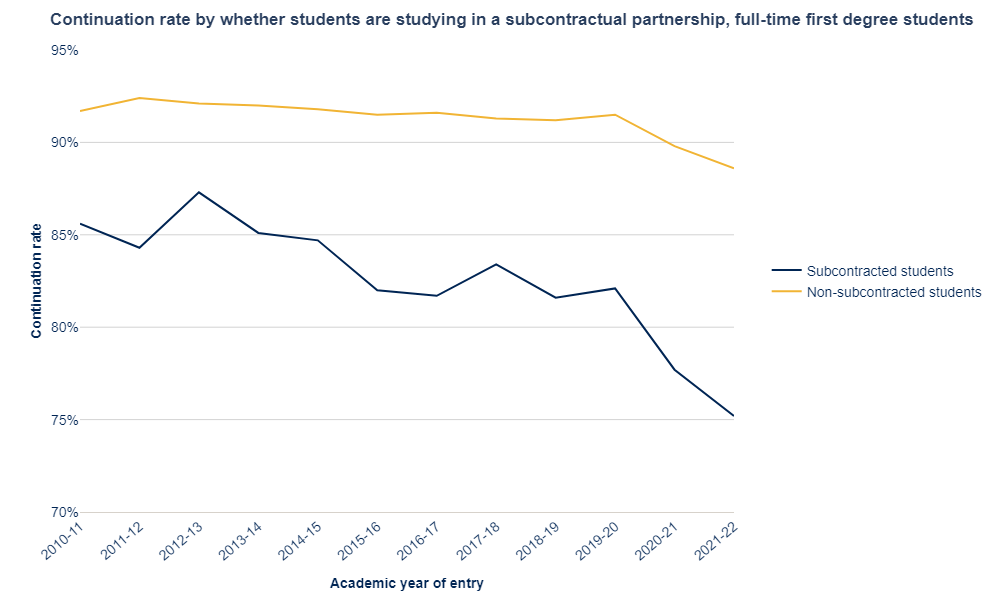Office for Students Head of Student Outcomes, Graeme Rosenberg, reflects on the ways in which providers and the OfS are using data to inform work on delivering positive outcomes for students.

Making sure that students achieve ‘positive outcomes’ – that they succeed in their studies and are set up for whatever they do next – is central to our role as a regulator.
To this end, we have worked with the higher education sector in many different ways. In 2022, we revised our condition of registration B3. This requires registered higher education providers to meet numerical thresholds for the proportion of students continuing, completing and progressing from their studies, which we refer to as student outcomes. We consider the provider’s own context and its student cohort when assessing its performance against these thresholds.
Since then, we have published annual data dashboards of individual provider performance and sector trends. We have assessed a number of providers against our requirements and published the findings. We also run the Teaching Excellence Framework (TEF), which among other things encourages universities and colleges to think carefully about how they deliver outcomes that benefit students through their education and higher education experience.
Among this work, we commissioned research to explore how providers are responding to our revised condition of registration.
The research, undertaken by Shift Learning, involved an initial telephone survey followed by in-depth case studies undertaken at four providers. The evaluation found that providers were already focused on improving student outcomes before we introduced the revised condition. The case studies explore how the providers used our revised thresholds and measures to update and strengthen their approaches, such as incorporating the thresholds into their course level monitoring, developing their own internal data and realigning their annual quality monitoring to report on revised B3 measures. This helped them to understand and address potentially weaker areas of performance. Finally, the providers considered our regulatory requirements a key contributing factor in ensuring their improvement initiatives were carried out.
Enhancing student outcomes data
We are also building on the data we make available to providers. Today, we are publishing data on student outcomes from subcontractual partnerships, or franchised provision. This data comes from a pilot we ran with six lead providers and 17 delivery partners. We plan to roll this out to all subcontractual partnerships in England next year to continue building the picture on student outcomes from this type of provision, which has been growing rapidly.
Explore the pilot data dashboard
We also have plans to publish more data on student outcomes from other types of partnership provision in future. This will cover transnational education (where English higher education providers deliver, franchise or validate courses overseas) and partnerships where the provider validates courses delivered by other providers in England.
The continuing student data story
Our sector-level data shows the sector as a whole continues to deliver strong outcomes for students during and after their studies. We recognise a lot of hard work goes into supporting students from a wide range of backgrounds to achieve positive outcomes. However, beneath this overall picture there’s a downward trend forming for full-time students continuing in their first degree, decreasing from a sector average of 91.1 per cent as published in 2022 to 89.5 per cent in data published in 2024. We’ve identified four overlapping areas with more significant decreases.
First is the continuation rate for students studying with an integrated foundation year, which our analysis suggests has seen a marked downturn. As shown in the chart below, for 2019-20 entrants, the continuation rate for students that had undertaken a foundation year was around 9 percentage points lower than for other students. For 2021-22 entrants this gap widened to 15 percentage points and has fallen below our numerical threshold of 80 per cent.

Second, the sector-level continuation rate for students studying in a subcontractual partnership has declined and has also fallen below our numerical threshold. Our recent Insights brief discusses the risks that may emerge from this type of provision, and the importance of effective management and governance to mitigate these risks.

Third, the continuation rate for students on business and management courses has seen a sharper downturn than other subject areas, as shown in the chart below.

Finally, our analysis shows a larger decline in continuation rates for students with lower or non A-level entry qualifications, than other students.

The data allows the OfS and providers to identify and understand sector-level changes. The four areas with more marked declines overlap and have seen rapid growth in recent years. Students on courses where this overlap occurs may need additional support to continue and succeed in their studies. We know that providers already look at their data to understand where improvements need to be made, and we encourage them to examine their provision in these areas in particular.
Our quality conditions require providers to understand their student cohorts, and where their academic support needs are greater, to deliver the support needed to ensure students can succeed. While foundation years provide an important access route into higher education, students on these courses are likely to require further support, as well as information to understand the demands of study for their foundation year and ongoing degree. It’s important providers understand and are able to provide the level of support these students may need so they can continue and progress through their education.
Looking beyond the data
Our assessments into providers’ compliance with condition B3 involved exploring each provider's context and their action plans to support their students’ needs. Our published reports are a valuable source of information about different approaches the assessed providers took to explain and improve their students’ outcomes, and I hope providers find them useful in their own discussions about quality.
In TEF 2023 assessments, we considered the student experience and student outcomes, which included providers’ explanations of what their students gain from their education beyond our measures of continuation, completion and progression. We commissioned analysis of providers’ TEF submissions which shows a rich variety of these wider benefits for students, and where there is scope for providers to develop further their approaches to supporting and measuring these educational gains.
Next steps
Following the Public Bodies Review of the OfS, we’re considering how we can most effectively bring together our quality assessment work of recent years into an integrated approach to quality. We look forward to working with the sector to draw together our qualitative and quantitative approaches to enable improvement across the sector, and ensure positive student outcomes are a central part of the integrated approach.

Comments
Report this comment
Are you sure you wish to report this comment?